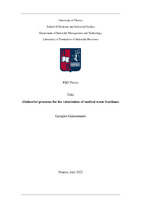Industrial processes for the valorization of medical waste fractions

Doctoral Thesis
Συγγραφέας
Γιακουμάκης, Γιώργος
Giakoumakis, Georgios
Ημερομηνία
2022-07Επιβλέπων
Σιδηράς, ΔημήτριοςSidiras, Dimitrios
Προβολή/
Λέξεις κλειδιά
Medical waste ; Medical cotton waste ; Medical paper waste ; Torrefaction ; Acid hydrolysis ; Enzymatic hydrolysis ; Severity factor ; Response surface methodologyΠερίληψη
Η παρούσα διατριβή καινοτομεί στην έρευνα για την αξιοποίηση κυτταρινούχων/λιγνοκυτταρινούχων κλασμάτων νοσοκομειακών αποβλήτων, με σκοπό την παραγωγή ενέργειας, καυσίμων και υλικών, στο πλαίσιο της κυκλική οικονομίας μηδενικών αποβλήτων. Αρχικά, πραγματοποιήθηκε εκτεταμένη βιβλιογραφική έρευνα με σκοπό τη συλλογή δεδομένων σχετικά με την παραγωγή των νοσοκομειακών αποβλήτων, τις μεθόδους συλλογής και διαχωρισμού αυτών και τις τεχνολογίες που χρησιμοποιούνται για την αξιοποίηση ή την τελική διάθεσή τους. Βάσει των δεδομένων που συλλέχθηκαν, σχεδιάσθηκε η πειραματική μελέτη, η οποία πραγματοποιήθηκε με σκοπό να αναδείξει την δυνατότητα του βαμβακιού και χαρτιού νοσοκομειακής προέλευσης για την παραγωγή ενέργειας μέσω αύξησης της θερμογόνου δύναμής του καθώς και τη δυνατότητα χρήσης αυτού ως προσροφητικό μέσο για την απορρύπανση υδάτων. Μελετήθηκε, επίσης, η επεξεργασία του νοσοκομειακού βαμβακιού και του χαρτιού με ενζυμική υδρόλυση .
Ειδικότερα, για την εξέταση της προσροφητικότητας καθώς και της ανώτερης θερμογόνου δύναμης του βαμβακιού των νοσοκομειακών αποβλήτων πραγματοποιήθηκε φρύξη (κοιν. καψάλισμα, torrefaction). Η προκατεργασία αυτή πραγματοποιήθηκε σε συγκεκριμένο εύρος θερμοκρασίας με μέγιστη τους 340 oC και διαφορετικούς χρόνους παραμονής, προκειμένου να μελετηθούν οι παράμετροι που επηρεάζουν την απόδοση της διαδικασίας. Πραγματοποιήθηκαν 14 πειράματα σε υψικάμινο. Για τη μέτρηση της θερμογόνου δύναμης στα δείγματα χρησιμοποιήθηκε θερμιδόμετρο Parr 1341 Plain Jacket Bomb και έγιναν 14 μετρήσεις. Στα ίδια δείγματα ελέγχθηκε και η προσροφητικότητα. Για την προσομοίωση των ρυπασμένων υδάτων δημιουργήθηκε διάλυμα που περιείχε μπλε του μεθυλενίου (Methylene Blue, C16H18ClN3S.xH2O), ενώ οι μετρήσεις των δειγμάτων έγιναν σε φασματοφωτόμετρο HACH DR6000 UV-VIS (λ=664 nm). Για την προσομοίωση των πειραματικών δεδομένων χρησιμοποιήθηκαν κατάλληλα κινητικά μοντέλα. Αξιοποιήθηκε ο συνδυαστικός παράγοντας σοβαρότητας (Combined Severity Factor, R0) που συνδυάζει σε μία μεταβλητή την επίδραση του χρόνου αντίδρασης και της θερμοκρασίας της φρύξης.
Στη συνέχεια πραγματοποιήθηκε μέσω του προγράμματος Design Expert ο πειραματικός σχεδιασμός (Design of Experiments, DoE) κατά Box-Behnken για την εφαρμογή της μεθοδολογίας επιφανειακής απόκρισης (Response surface methodology, RSM) με σκοπό τη μελέτη της επίδρασης της όξινης υδρόλυσης(με χρήση θειικού οξέος) στο κλάσμα βαμβακιού και χαρτιού των νοσοκομειακών αποβλήτων, ώστε να συσχετιστεί με το R0 ως προς τα πειραματικά αποτελέσματα. Ο πειραματικός σχεδιασμός αποτελείτο από 15 πειράματα για το βαμβάκι και 15 για το χαρτί. Στη συγκεκριμένη περίπτωση το R0, εκτός του χρόνου αντίδρασης και της θερμοκρασίας, εμπεριέχει και τη συγκέντρωση του οξέος που χρησιμοποιήθηκε. Τα προϊόντα που προέκυψαν από την κατεργασία του βαμβακιού μελετήθηκαν ως προς την προσροφητικότητα τους με 15 μετρήσεις, καθώς και ως προς την ανώτερη θερμογόνο δύναμη με 15 μετρήσεις. Τα πειράματα εκτελέστηκαν σε αντιδραστήρα διαλείποντος έργου (τύπου αυτοκλεί-στου) 3,75 L Parr 4553. Όλα τα παραπάνω πειράματα πραγματοποιήθηκαν στο Εργαστήριο Προσομοίωσης Βιομηχανικών Διεργασιών του τμήματος Βιομηχανικής Διοίκησης και Τεχνολογίας του Πανεπιστημίου Πειραιά.
Για την ανάλυση της σύστασης των δειγμάτων της στερεής φάσης, χρησιμοποιήθηκε το σύστημα υγρής χρωματογραφίας υψηλής απόδοσης (HPLC) 1260 Infinity II LC System, της Agilent με χρήση στήλης Aminex HPX-87H στους 50 oC, μετά από ποσοτική σακχαροποίηση αυτών με την πραγματοποίηση 30 μετρήσεων για κάθε ένα κλάσμα. Η ίδια διαδικασία χρησιμοποιήθηκε και στην ανάλυση της υγρής φάσης, με σκοπό τον προσδιορισμό της ποσότητας και του είδους των συνολικών σακχάρων και τον έλεγχο για προϊόντα αποικοδόμησης αυτών. Πραγματοποιήθηκαν 30 μετρήσεις για την κάθε μία στερεή φάση (βαμβάκι και χαρτί) και 30 μετρήσεις για την κάθε μία υγρή.
Τα στερεά δείγματα χρησιμοποιήθηκαν για την παραγωγή ζυμώσιμης γλυκόζης μέσω ενζυμικής υδρόλυσης. Το ενζυμικό μείγμα Cellic® CTec2 της Novozymes A/S χρησιμοποιήθηκε για την υδρόλυση των δειγμάτων η οποία πραγματοποιήθηκε στους 50 oC. Δείγματα ελήφθησαν μετά από 24 και 48 ώρες και στη συνέχεια αναλύθηκαν με τη μέθοδο DNS (δινιτροσαλικυλικού οξέος) και της μεθόδου glucotest με χρήση φασματοφωτόμετρου (30 μετρήσεις στις 24 και 30 στις 48 ώρες για κάθε μέθοδο και κάθε υλικό). Αυτά τα πειράματα πραγματοποιήθηκαν στο Eργαστήριο Bιοτε-χνολογίας της Σχολής Χημικών Μηχανικών του Μετσόβειου Πολυτεχνείου.
Σύμφωνα με τα αποτελέσματα, το βαμβάκι στα νοσοκομειακά απόβλητα είχε καλύτερη απόδοση από το χαρτί ως πηγή θερμότητας. Ομοίως, απεδείχθη καλύτερο προσροφητικό υλικό, ιδίως μετά από την επεξεργασία της του με όξινη υδρόλυση. Επίσης, παρουσίασε μεγαλύτερη απόδοση μετατροπής σε ζυμώσιμη γλυκόζη από το χαρτί στα νοσοκομειακά απόβλητα, κάτι που το καθιστά μία πολλά υποσχόμενη πηγή ενέργειας και υλικών στα πλαίσια της κυκλικής οικονομίας μηδενικών αποβλήτων.

